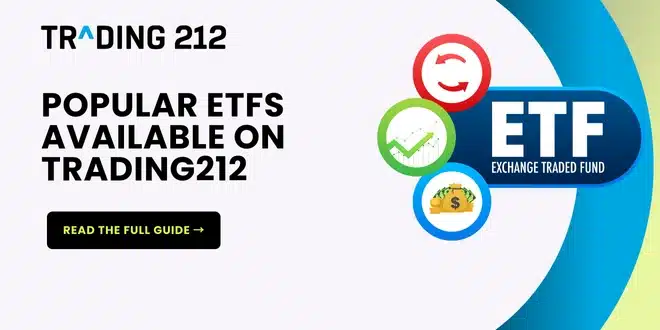You don’t need to be a stock-picking genius or spend hours analyzing charts to grow your money. With ETFs on Trading212, you can start building a strong, diverse portfolio — even with just a few pounds, euros, or dollars.
But which ETFs are worth your attention in 2025?
This guide breaks down the most popular ETFs available on Trading212, based on platform data and real feedback from beginner and intermediate investors. Whether you want long-term growth, steady income, or exposure to exciting sectors like clean energy or tech, you’ll find something here that fits.
What Are ETFs, and Why Do People Choose Them?
An ETF (Exchange-Traded Fund) is a basket of investments — usually stocks or bonds — that you can buy and sell just like a single stock. It’s one of the easiest ways to invest in a wide range of companies without buying each one individually.
Why ETFs are great for new investors:
- Diversification: One ETF often holds hundreds of assets
- Low cost: Cheaper than mutual funds or active management
- Simplicity: No need to guess which company will win
- Easy access: Trading212 offers many ETFs with no commission and fractional shares
ETFs help you grow over time with less stress and risk than picking individual stocks — perfect for people starting out.
Popular ETFs Available on Trading212 (Updated for March 2025)
These ETFs are favorites among Trading212 users, based on popularity, volume, and forum discussions.
1. iShares Core MSCI World UCITS ETF (IWDA or SWDA)
- ~1,500 companies from developed countries (US, UK, Japan, Germany, more)
- Includes Apple, Nestlé, Samsung, Microsoft
- Ideal for long-term passive growth
Why it’s a go-to choice: It’s simple, global, and widely recommended in the investing community as a “buy and hold” core ETF.
2. Vanguard S&P 500 UCITS ETF (VUSA)
- Covers 500 top US companies
- Sectors: Tech, health care, finance
- Top holdings: Microsoft, Amazon, Apple, Meta
- Why it’s popular: It’s reliable, low-cost, and historically one of the best-performing indexes over time.
3. iShares Core FTSE 100 UCITS ETF (ISF)
- Top 100 companies in the UK
- High dividend potential (banks, energy, consumer goods)
- Popular among UK investors focused on income
Why it stands out: It aligns with GBP and offers some stability during global market turbulence.
4. Vanguard FTSE All-World UCITS ETF (VWRL)
- 3,000+ stocks from around the globe — including emerging markets
- Broader than IWDA (includes India, Brazil, etc.)
- Good for total global exposure
Why users like it: One ETF, total world coverage. Ideal for people who don’t want to think about regions.
5. Invesco EQQQ NASDAQ-100 UCITS ETF (EQQQ)
- Focus on the Nasdaq 100 (mostly big tech)
- Apple, Nvidia, Tesla, Meta, and more
- High-growth, higher-risk
Who it’s for: People who want more excitement and tech-driven potential in their portfolio.
6. iShares Global Clean Energy UCITS ETF (INRG / ICLN)
- Solar, wind, and renewable companies worldwide
- Includes Enphase, Vestas, and First Solar
- ESG-aligned and socially conscious
Why it’s growing in interest: Combines sustainability with investment potential — especially attractive to younger investors.
7. Lyxor MSCI Emerging Markets UCITS ETF (LEM / EEM)
- Companies in China, India, Brazil, South Africa, and more
- Broad mix of tech, finance, and natural resources
Why it’s often added as a side holding: It complements safer global ETFs with higher risk and growth potential.
Broad vs. Thematic ETFs: What’s the Difference?
Understanding the ETF type helps avoid portfolio overlap and manage risk.
Broad ETFs (e.g. IWDA, VUSA, VWRL):
- Lower volatility
- Long-term growth-focused
- Ideal for the core of your portfolio
Thematic ETFs (e.g. INRG, EQQQ, LEM):
- Focus on specific sectors (like tech or clean energy)
- Higher upside potential, but more volatility
- Great for expressing your beliefs or market outlook
Tip: Many long-term investors use a broad ETF for their base, then add a thematic ETF for extra growth or diversification.
Beginner-Friendly Portfolio Examples (Based on Risk Level)
Here are sample ETF allocations that real users might use, depending on their goals:
Conservative (Low Risk)
- 70% IWDA
- 30% ISF (UK income + stability)
Balanced (Medium Risk)
- 60% VWRL
- 25% EQQQ
- 15% INRG (for growth themes)
Aggressive (High Risk / High Growth)
- 50% VUSA
- 30% EQQQ
- 20% LEM (emerging markets)
Important: These examples are not advice, but they show how to mix ETFs for different comfort levels and goals.
Top ETFs to Add to Your Trading212 Watchlist
Want to track ETFs before you buy? Here are some popular picks traders keep on their radar:
- IWDA – Global developed markets
- VWRL – Full world coverage, including emerging markets
- VUSA – US S&P 500 exposure
- ISF – UK-focused with strong dividends
- EQQQ – High-growth US tech stocks
- INRG – Clean energy and ESG investing
- LEM – Emerging markets potential
Pro tip: Use Trading212’s “watchlist” and “pie” tools to experiment and learn risk-free.
Final Thoughts
ETFs are one of the easiest and smartest ways to invest through Trading212 — especially for beginners. You can start small, stay diversified, and grow at your own pace.
Whether you want something simple like IWDA, powerful like VUSA, or thematic like INRG, you’ll find a wide range of commission-free ETFs that match your values and your goals.
Build slowly, learn as you go, and take advantage of features like fractional shares and AutoInvest pies. You don’t need a lot to get started — just a plan and consistency.
FAQs
1. Can I buy ETFs with just £1 or €1? Yes. Trading212 offers fractional shares, so even small deposits let you own a slice of top ETFs.
2. Do all ETFs pay dividends? No. Some are distributing (they pay out dividends), others are accumulating (they reinvest dividends into the fund). Always check the ETF type.
3. Are these ETFs ISA-friendly? Yes, most of the ETFs listed here are UCITS-compliant and eligible for UK ISA accounts.
4. How often should I invest in ETFs? Many investors use monthly AutoInvest or a weekly deposit system — this helps smooth out price fluctuations (called dollar-cost averaging).
5. Can I mix multiple ETFs? Yes — but avoid overlapping too much. For example, IWDA and VUSA both hold US stocks, so you might not need both.
6. Do I need to sell my ETF to get the dividend? No. If it’s a distributing ETF, you’ll receive cash into your account automatically. If it’s accumulating, the value will go up over time instead.
7. Is it safe to invest only in one ETF? It can be — especially if it’s something broad like IWDA or VWRL. These already include thousands of companies across many countries.


